Recent Bookmarks
How do I get started with the Team plan? | Claude Help Center

Elders Cultural Transfers Video: Reg Crowshoe on Oral Systems

How to implement AI Companion and train employees | Zoom

Zoom’s AI Companion Onboarding resources
Get help introducing AI Companion to your organization with our collection of user guides, templates, best practices, demo videos, and more.
Going Deeper with Empathy Maps for Instructional Design
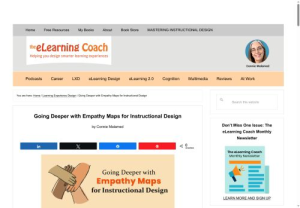
Empathy maps help learning designers see beyond surface-level traits to better grasp what motivates and challenges their audiences.
Selected text
Empathy maps bring learners’ perspectives into sharper focus, revealing insights that can transform how you design and create learning experiences
The Unsung Builders of Online Learning; IU Online

A centralized coordinating body, aligning and supporting online learning efforts across the Indiana University system
Selected text
IU Online serves as the central organization supporting online learning across Indiana University’s (IU) seven main campuses. Unlike many institutions that have expanded online by establishing separate campuses or new degree-granting entities, IU Online instead operates as a coordinating body, aligning and supporting online learning efforts across the Indiana University system. This isn’t a model often seen outside community college systems. A few university systems have attempted similar approaches, but Indiana is relatively rare in having made it work, and at scale.
A Strategic Plan Typology | HESA
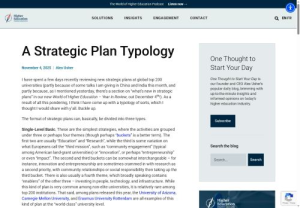
Selected text
I have spent a few days recently reviewing new strategic plans at global top 200 universities (partly because of some talks I am giving in China and India this month, and partly because, as I mentioned yesterday, there’s a section on “what’s new in strategic plans” in our new World of Higher Education – Year in Review, out December 4th!). As a result of all this pondering, I think I have come up with a typology of sorts, which I thought I would share with y’all. Buckle up.
The format of strategic plans can, basically, be divided into three types.
SPACE TYPE GENERATOR

AI Sandbox | Harvard University Information Technology

Explore generative AI in this secure environmentApproved to handle data classified as: Level 3
The AI Sandbox provides a secure environment in which to explore Generative AI, mitigating many security and privacy risks and ensuring the data entered will not be used to train any vendor large language models (LLMs). It offers a single interface that enables access to the latest LLMs from OpenAI, Anthropic, Google, and Meta. Features include image generation, data visualization, and the ability to upload multiple files.
Compliance with University guidelines for use of generative AI required for use.
The Teaching Game: Strategic Course Design

VisPubs Games

An Examination of Canadian Post-Secondary Faculty Beliefs Concerning Learning Strategies | The Canadian Journal for the Scholarship of Teaching and Learning

Instructors have opinions.
Even though faculty opinions were not in line with recognized evidence, their views provide insight into the learning strategies perceived as beneficial and those that students may be using
Enhanced Conceptual Learning with Real Time Student-Generated Data and Visualization | The Canadian Journal for the Scholarship of Teaching and Learning

Interactive student response systems (SRS, clickers) are used in post-secondary classrooms to enhance student engagement and learning. Their use, however, is most often limited to reviewing material with multiple choice questions. The present study examined student responses to a strategy for technology-enhanced learning within an introductory understanding research course to improve student experiences
Impacts of the Active Learning Classroom on Student Learning and Engagement: The Role of Technology | The Canadian Journal for the Scholarship of Teaching and Learning

Gah, with the forced acronyms.
This study examines student learning outcomes and engagement in a high-tech active learning environment compared to a low-tech active learning environment at both the individual lesson and overall course levels. A quasi-experimental design was employed, where two sections of students in a college Microeconomics course experienced a high-tech active learning classroom, while the other two sections engaged in the same activities in a low-tech classroom. Student perceptions of enjoyment were measured using the ENJOY scale, comprising five subscales: Pleasure, Relatedness, Competence, Challenge/Improvement, and Engagement
Turning crisis into opportunity: how entrepreneurs can thrive in turbulent times | News | University of Calgary

New study sets out to explore how AI can help minority-owned businesses turn disruption into innovation
HathiTrust Digital Library
The Fuzzy Front Ends: Reflections on the Never-Ending Story of Visualization Co-Design
Co-design is an increasingly popular approach in HCI and visualization, yet there is little guidance on how to effectively apply this method in visualization contexts. In this paper, we visually present our experience of a two-and-a-half-year co-design project with the local arts community. Focusing on facilitating community exploration and sense-making around arts funding distribution, the project involved a series of co-design sessions between visualization researchers and members of the arts community. Through these iterative sessions, we built shared understanding and developed visualization prototypes tailored to community needs. However, the practice is far from complete, and we found ourselves continually returning to the “fuzzy front end” of the co-design process. We share this ongoing story through comic-style visuals and reflect on three fuzzy front ends that we encountered during the project. By sharing these experiences with the visualization community, we hope to offer insights that others can draw on in their own community-engaged co-design work.
GenAI - Academic Integrity | University of Saskatchewan

The AI3 Model: Future Directions for Artificial Intelligence, Assessment Innovation, and Academic Integrity - Christopher DeLuca, Louis Volante, Michael Holden, 2025

This article investigates this timely issue by examining the intersections between AI, academic integrity, and assessment innovations through a cross-national research synthesis, resulting in a novel model for educators, policymakers, and researchers. The proposed model promotes assessment policies and practices that support high integrity, authentic learning, and innovative student assessment in an era of generative AI.
We’re Losing the Thread on AI in Education
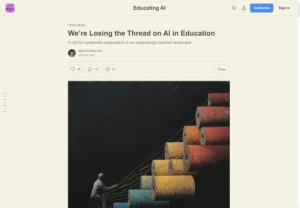
A call for systematic preparation in an increasingly reactive landscape
Selected text
Cognitive atrophy. An MIT study found that students who relied on ChatGPT to write essays showed diminished neural connectivity and couldn’t recall what they’d written minutes before. Eighty-three percent of AI users in the study couldn’t remember a single correct quote from essays they had just composed. The concern: we’re outsourcing thinking itself, and our brains are paying the price. Students might get correct answers, but they’re not developing the procedural fluency that enables genuine critical thought.
AI slop. Low-quality, AI-generated content now comprises half of all internet articles. Students wade through oceans of bland, generic, sometimes nonsensical material when they’re trying to research. UNESCO warns against AI’s tendency to produce “bland, generic, average, anodyne” content that crowds out more interesting perspectives. Teachers assign research projects, and students return with work that looks polished but is built on a foundation of algorithmically generated mediocrity.
Some Thoughts on the Use of AI in Teaching | HESA
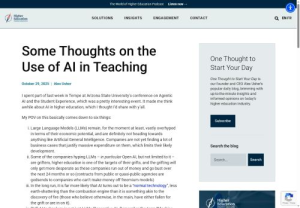
I spent part of last week in Tempe at Arizona State University’s conference on Agentic AI and the Student Experience, which was a pretty interesting event. It made me think awhile about AI in higher education, which I thought I’d share with y’all. My POV on this basically comes down to six things: That last one […]
Selected text
Anyways, long story short: getting good at applying any new technology to pedagogy, AI or no, really comes down to time, resources, a willingness to experiment and a determination to share experiences and promote good practice at scale. The problem most universities have with technology adoption processes isn’t that institutions and/or faculty are anti-technology; it’s that modern universities make very little space available to talk pedagogy or to properly resource experimentation in pedagogy.
A Geopositioning View of Teachers’ Orchestration in Active Learning Classrooms: Following Teachers’ Location Within the Classroom
A logical extension of active learning pedagogies (e.g., Chickering & Gamson, 1987) are active learning classrooms (e.g., the SCALE-UP & TEAL models). Just as the learning locus has shifted from teacher as sage on the stage to teacher facilitator supporting students’ activity (King, 1993), the architecture of classrooms must also change. We define Active Learning Classrooms (ALCs) as technology-rich collaborative learning environments, which support students’ learning experiences. These innovative spaces are intended to create a student-centered environment that encourages collaboration and communication among learners. Learning becomes distributed across the physical space because there is no definite “front” to the classroom: the teacher desk is often repositioned to the center of the room, if it exists at all, and rows of desks are replaced with group tables. As adapting to supporting students’ needs drives the learning agenda, teachers no longer fully control what will happen in the classroom. Teachers must now manage feedback from multiple streams (visual, aural, oral, technological) and adaptively react adaptively. Such work can be characterized as orchestration, the real-time management of activity, along with the management of classroom resources (e.g., Dillenbourg & Jermann, 2010). As a research topic, orchestration has gaining much interest in the CSCL community (Dillenbourg, 2013). This moment-to-moment management of the constraints of the classroom ecosystem, coupled with the management of the learning, places greater demands on the teacher than traditional classrooms and traditional instruction. Physical space and layout are important orchestrational considerations (Dillenbourg & Jermann, 2010). Where the teacher is located, what the teacher can access does make a difference to the possible interactions and feedback to learners.
Anatomy Video and Imagery Diversity Project
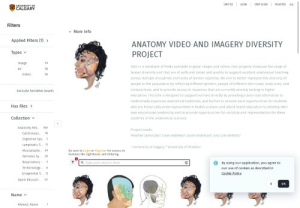
AVID is a database of freely available original images and videos that properly showcase the range of human diversity and that are of sufficient detail and quality to support excellent anatomical teaching across multiple disciplines and levels of learner expertise. We aim to better represent the diversity of people in the population by reflecting different genders, people of different skin tones, body sizes, and compositions, and to provide access to resources that are currently severely lacking in higher education. This OER is designed to support learners directly by providing a zero-cost alternative to traditionally expensive anatomical textbooks, and further to provide paid opportunities for students who are historically underrepresented in health sciences and allied health education to develop their own educational leadership and to provide opportunities for visibility and representation for these students in the anatomical sciences.
Inside Calgary’s Fight Over Fluoride in the Water - The New York Times

We just keep trying with referenda until the desired answer sticks. (which is why the referendum on “should Alberta stay in Canada - just asking questions LOL” is so corrosive.
Calgary’s debate over fluoride has drawn national attention in part because of how far back it goes — there have been seven referendums on the issue since 1957, four of them won by opponents of fluoride and three by supporters.
CSU AI Workforce Acceleration Board | CSU AI Commons
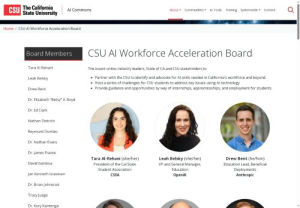
DxHub – AWS at Cal Poly
